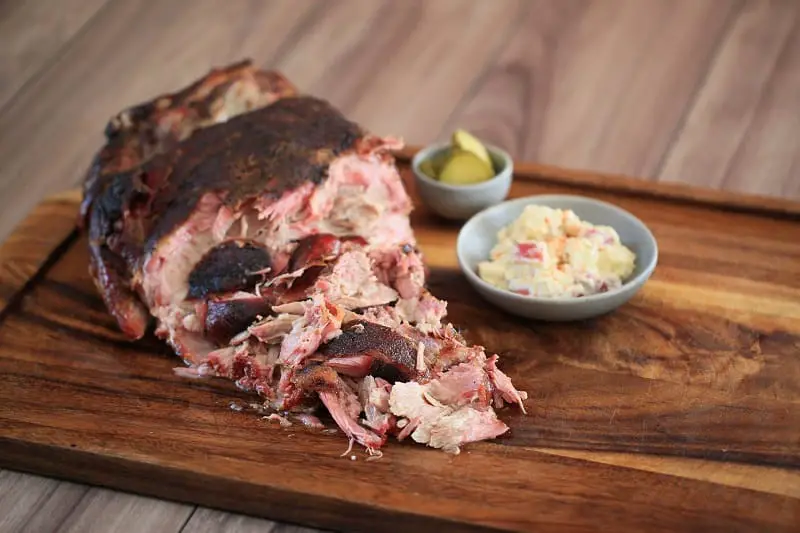The heavenly aroma of slow-cooked pork butt is enough to send anyone into full anticipation mode. That rich, smoky flavor that magically melds with juiciness can easily leave you craving more. But how do you know the perfect time to pull the pork butt? Achieving this tender, mouthwatering deliciousness requires a firm understanding of the process and timing involved.
In this article, we’ll provide you with indispensable tips to successfully pull pork butt and serve a feast that will have your family and friends asking for your secret. From ideal cooking temperatures to determining the perfect texture for your slow and low masterpiece, we have everything you need to ensure a flavorsome pulled pork butt. Get ready to dive into the bold, savory world of low and slow cooking and learn when to pull pork butt like a pro!
When to Pull Pork Butt?
According to the experts, it seems that the magic number is around 195°F. But here’s the thing, my friends, it’s not just about the temperature. You need to go beyond the numbers and rely on your senses. Once your trusty thermometer tells you that the internal temperature has hit the mark, it’s time to put your pork-poking skills to the test. Yes, you heard me right. Poke that butt and feel for tenderness. It’s like giving your meat a little massage to see if it’s ready to be devoured. So keep probing every few degrees until you reach that sweet spot where the meat is just melt-in-your-mouth tender.
How Does Bone Tenderness Affect The Timing For Pulling Pork Butt?

The pork butt, cut from the shoulder of the hog, is a heavily-worked muscle on the animal and contains a lot of connective tissue. The collagen in the connective tissue gives pulled pork its signature moist and silky texture. Therefore, to properly break down the connective tissues, pork butt needs to be cooked to a higher internal temperature (91-96°C). The art of smoking meat involves taking tough cuts of meat and turning them into tender, juicy, and flavorful masterpieces.
To achieve the desired tenderness in pork butt, experts recommend keeping the internal air temperature of the smoker at about 107°C during the cook for as long as 18 hours. However, it is possible to achieve similar results by cooking pork butt at a higher smoker temperature, resulting in almost half the cooking time while preserving the flavor and moisture. It is important to note that when selecting pork butt for barbecue, choosing a cut with more exterior fat intact is preferable to ensure a juicy and tender end product.
Read more:
- How Long To Smoke Country Style Ribs At 225
- Beginner’s Guide: How Long To Smoke Pork Butt At 225 Degrees
- When Is Pork Butt Done
- How Long To Thaw Pork Shoulder
How Long Should You Rest Pork Butt Before Pulling?

Resting is essential in creating a great barbecue, especially with pork butt. The pork butt must rest after smoking to allow the juices to redistribute. If you are in a time crunch, the minimum rest time is 30 minutes, but it is recommended to rest for at least an hour for maximum tenderness. You can hold the meat at a steady temperature of 150°F indefinitely, but it is crucial to watch your internal temperature to ensure the meat does not enter the Danger Zone.
A pork butt should not be sliced right after smoking because it will lose its juiciness due to evaporation. Resting for about 15 minutes is recommended, but it can continue to rise in temperature for up to 10 degrees. The longest recommended rest time is two hours to avoid the temperature range where harmful bacteria grow. Covering the pork butt during rest time is optional; however, it does add a layer of protection from dirt and contaminants.
How to Make Pulled Pork?

With this simple recipe, you can make the perfect pork butt every time. First things first, let’s gather our ingredients. You’ll need the following:
- 4 lb pork shoulder or butt
- 2 tablespoons of oil (optional if searing)
- 1 tablespoon of brown sugar
- 1 tablespoon of chili powder
- 1 teaspoon of onion powder
- 1 teaspoon of garlic powder
- 1 teaspoon of cumin
- 1 teaspoon of kosher salt
- 1 teaspoon of black pepper
- 12 ounces of Coke (not diet)
- Some BBQ sauce for coating the meat (optional).
Once you have your ingredients ready, it’s time to get cooking.
- Start by trimming excess fat from your pork and cutting it into 4 pieces. Then, combine all of your spices in a small bowl and rub them all over the pork.
- If you want to take your pork to the next level, sear it before cooking. Heat a few tablespoons of oil in a Dutch oven pot over medium-high heat, then add the meat and sear for a few seconds on all sides.
- Next, it’s time to cook the pork. Preheat your oven to 300 degrees F and pour the coke around the pork in the Dutch oven pot. Cover the pot with a lid and cook for 3 hours. After 3 hours, remove the lid and cook for 1-2 hours, until the pork is tender and easily pulls apart with a fork.
- Once your pork is cooked, please remove it from the oven and shred the meat. Then, toss it in some BBQ sauce if desired. And that’s it! You now have a delicious, juicy pork butt perfect for any occasion.
With just a few simple ingredients and some time in the oven, you can have a mouth-watering protein that’s sure to impress. So go ahead and give it a try – your taste buds will thank you.
Should You Wrap Pork Butt In Foil Before Pulling?
When it comes to smoking a pork butt, there is a debate on whether to wrap it in foil before pulling. Some pitmasters swear by it because it seals in moisture and speeds up the cooking process, while others argue that it can result in a soggy exterior and interfere with the smoky flavor.
However, the right time to wrap pork butt in foil is when the internal temperature reaches 150 and 170 degrees Fahrenheit. This is where the stall occurs; wrapping the meat can help overcome it. A meat thermometer is crucial to determine this temperature, and the wrapping technique should be chosen based on personal preference. Wrapping pork butt can be beneficial in some cases, but it ultimately depends on the desired outcome of the meat.
What Is The Best Rub For Pork Butt When Pulling?

Using a rub is key when getting the best flavor from your pork butt. Many people have their preferences, but a few ingredients are essential in an excellent pork butt rub. Brown sugar, sea salt, and pepper are typically used for a sweet and salty flavor with a hint of heat. Onion powder and garlic powder add a base of flavor that pairs well with the tender pork. Dried mustard and cayenne pepper give it a nice bite, while smoked paprika adds a smoky flavor.
FAQs
Why Is Bone Movement A Sign Of A Successfully Cooked Pork Butt?

Signs of a successfully cooked piece of meat. The pork butt is a heavily-worked muscle containing tough protein fibers connected by connective tissue. To achieve optimal tenderness, low cooking temperatures over time are required. The bone will move freely as collagen dissolves into gelatin and fat is rendered. This happens when the internal temperature of the meat reaches around 195-203°F (91-96°C), which helps break down the connective tissue and results in a succulent texture.
It is recommended to use accurate temperature tools and carefully monitor the temperature of the smoker and the meat to achieve the desired results. Additionally, starting with a good quality cut of meat, trimming excess fat, using a binder to help the rub stick, and injecting the pork butt with a brining or braising liquid can also contribute to a delicious final result. Bone movement is a reliable indicator of a perfectly cooked pork butt – tender, juicy, and flavorful.
What Is A Smoke Ring, And How Does It Contribute To The Taste And Appearance Of Pulled Pork?
A smoke ring is a thin pink layer that appears just below the surface of the meat, most commonly in beef and pork cuts. It results from a chemical reaction between nitric oxide and carbon monoxide produced by wood smoke and a protein called myoglobin present in the meat. This reaction prevents myoglobin from oxidizing and keeps it a bright pink color. While the smoke ring adds no flavor to the meat, it is considered visually appealing and is often sought after in competition barbecues.
The thickness of the smoke ring depends on the amount of nitric oxide that penetrates the meat and can be promoted by keeping the surface of the meat moist and using a water pan or spritzing the meat with water or flavorful liquids. The smoke ring does not penetrate deeply into the meat, and, as a result, the inner parts of the cut will turn brown as it cooks, leaving the pink ring just below the surface.
Are Any Cuts Of Meat Similar To Pork Butt That Can Be Pulled?
Several substitutes are available for those unable to find pork butt in their local stores or to look for a healthier alternative.
- Beef chuck roast is a flavorful and tender cut of beef that can replace pork butt in any recipe, adding a delicious beefy flavor.
- Beef brisket is another substitute that has a similar texture to pork butt and can be shredded easily.
- Pork shoulder is leaner and has a milder flavor than pork butt, making it a great substitute for healthier options.
- Chicken thighs are also a versatile substitute that can be used in various recipes, such as chicken tacos or chili.
- For those following a plant-based diet, Jackfruit is a vegan option miming pulled pork’s texture.
Can You Pull A Pork Butt Straight From The Smoker Or Grill, Or Should You Let It Cool First?
When pulling a pork butt straight from the smoker or grill, it is best to let it cool down first. This allows the meat to rest and the juices to redistribute, resulting in a more tender and flavorful pulled pork. Pulling the meat while still hot can lead to dryness and a tough texture. Letting the meat cool for 20-30 minutes before pulling it apart with forks or meat claws is recommended. Additionally, gloves are advisable to protect your hands and prevent the meat from becoming contaminated. Proper cooling and safe handling allow you to enjoy delicious, juicy pulled pork every time.
When to Pull Pork Butt – Conclusion
In conclusion, pulling pork butt is essential to creating delicious barbecue. While you can follow a few guidelines, the answer to when to pull pork butt ultimately comes from personal preference and experience. Trust your instincts, use a meat thermometer, and don’t be afraid to experiment until you find the perfect combination of tenderness and flavor.
References:
- https://www.bhg.com/recipes/how-to/cooking-basics/how-to-make-pulled-pork/
- https://tastesbetterfromscratch.com/pulled-pork/
- https://www.traeger.com/learn/pulled-pork
- https://www.tastingtable.com/878171/the-best-way-to-fix-overcooked-pulled-pork/

Hey there, it’s Maura Braun from Maura’s Kitchen of Millbrook! If you love all things BBQ and grilling, my blog is the perfect place for you. But my passion for food doesn’t stop at the restaurant. I also love sharing my smoker, grilling, and BBQ experiences on my blog. From juicy brisket to perfectly smoked ribs, I’m always experimenting with new techniques and flavor combinations.
